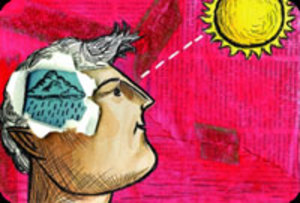The main color of your room can have an effect on your mood. These colors can make you feel anything from tranquil to rage. So when trying to create peace and harmony in your home choose your colors wisely. Some colors in large amounts will have just the opposite affect on you and your loved ones’ moods.
Ancient cultures used colors also for therapeutic reasons. The use of colors to heal the body is known as Chromotherapy.
Red:
With red invoking feels of rage and hostility is a color that should be avoid as the main color of a room. Sitting for long periods of time in a room this color will likely breakdown any peace and harmony you are striving to create in your home.
Ancient cultures used the color red to stimulate the body and mind and to increase circulation.
Blue:
Blue is known to have a calming effect when used as the main color of a room. When going with blue go for softer shades of blue. Dark blue has the opposite effect. Dark blue evokes feels of sadness. So refrain from using darker blues in your main color scheme. Stay with the lighter shades of blue to give you and your loved ones a calm effect.
Blue was used by ancient cultures to treat pain.
Green:
Green also has a calming effect when used as a main color for decorating. It is believed to relieve stress by helping people relax. Also believed to help with fertility this is a great choice for the bedroom. Green M& M’s are said to send a sexual message. This can also be applied to the color of your room and not just the color of the candy you eat. So once again green is a great choice for the bedroom.
Researcher has found the green can also improve reading ability. By laying a transparent sheet of green paper over a page in a book you can increase reading speed and comprehension.
Orange:
Orange evokes excitement, enthusiasm and is an energetic color. While not a good idea for a living room or for bedrooms this color is great for an exercise room. It will bring all the emotions out that you need when jumping into your fitness routine.
In ancient cultures orange was used to heal the lungs and increase energy levels.
Yellow:
Yellow although is a cheery color is not a good choice in main color schemes of a room. People are more likely to lose their tempers in a yellow room. Babies also seem to cry more in a yellow room. This color tends to create feeling of frustration and anger in people. This color is the most fatiguing on the eyes.
In chromotherapy yellow was believed to stimulate the nerves and purify the body.
White:
White can make a room appear spacious but it also makes the room seem unfriendly. So when going with white add color accents in the room to lend a friendly and inviting touch. White is also described as cold, bland and sterile.
Hospitals use white to create a sense of sterility.
Some colors work best in certain rooms. Some are not good to use in any room of your house. These are some great books that can give you a more in-depth look at color psychology and chromotherapy. I have found these books to be helpful in learning what colors to use and what ones to avoid.
Color Psychology and Color Therapy
By: Faber Birren
Color Therapy: Healing with Color
By: Reuben Amber
The Psychology of Color & Design
By: Deborah T. Sharpe




